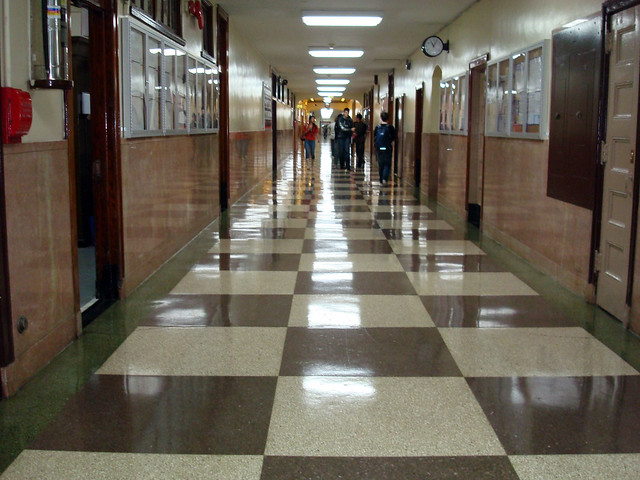When New York City’s highly selective public schools released their admissions breakdown for the incoming freshman class in March, Stuyvesant High School gained national attention for admitting only 7 black students out of 895 spots. This staggeringly low number reflects a larger ongoing regression in the city, as African American admissions into these public schools has steadily declined over the past two decades. Admissions into these schools are based on one high-stakes test administered to 8th graders: the SHSA.
NYC Mayor Bill de Blasio is currently backing an extreme structural change to increase the diversity at these elite schools: completely throwing out the SHSA. De Blasio’s plan is to admit students based on their middle school class rank and scores on the statewide standardized test, which could produce a more equitable distribution. De Blasio’s plan would ensure admittance to the top 7% of every NYC public middle school and reserve a certain number of spots for private school students. This re-distribution would result in fairer demographic representation within the city’s elite public schools. Furthermore, De Blasio intends to increase the amount of seats reserved for low-income students who score just below the test cut off during the years in which the test is phased out.
Under de Blasio’s plan, black student-enrollment is expected to increase five-fold, reaching percentages much closer to the proportion of black students in the city. Furthermore, it addresses the issue of school disparity, as more than half of all students accepted into one of these specialized schools came from just 21 middle schools even though almost 600 exist in the city.
However, one major demographic is being left out of Mayor de Blasio’s plan: Asian Americans. At Stuyvesant, Asian Americans make up 74% of the student body, and the majority of these students come from low-income families. Mayor De Blasio has backed a plan that increases seats for the African American and Hispanic communities at the direct expense of the Asian American community. Because there are a limited number of seats at these specialized schools, and the Mayor’s plan does not include the addition of any more seats, the percentage of Asian American students is projected to drop by half. This is a dramatic loss to the Asian American community, who for decades have counted on these specialized schools for a pathway out of the lower class.
This SHSA is unique to New York City, as it is the only city in which admissions are required to be based solely on one exam. Many students spend years and thousands of dollars preparing for the test, evidently increasing the likelihood that higher-income students be admitted to these prestigious schools. However, at Stuyvesant, the school with the highest test cutoff, this narrative is not as clear-cut, because a large portion of the school’s student body is low-income.
While there exists stereotypes of an abundance of money being spent by Asian American families for the test, the reality is that Asian Americans are the poorest immigrant group in New York City. Furthermore, 43% of Asian children in poverty live in households isolated by language, where no adult in the household speaks English.
This is not the first time Mayor De Blasio has disregarded the Asian American community of NYC. The Mayor’s recent crackdown on electric bikes, which are essential to many immigrant delivery workers, is just one of the city’s countless legislative actions that have disadvantaged the Asian American community.
The Asian American Federation blames the Mayor not only for fueling racial divisions in the city and for excluding Asian American communities from conversations about the issue of diversity at specialized public schools. Both sides of the issue can agree that the current state of diversity at these schools is not acceptable. However, by proposing to cut Asian American students’ seats in half without providing any support to Asian American communities, the Mayor is excluding a crucial group of stakeholders from voicing their concerns about this markedly complex issue. Democrat Congresswoman Grace Meng, noted that she and other Asian American lawmakers were not included in talks with the Mayor’s office before the unveiling of the plan.
The complicated issues related to diversity in NYC public schools is a prime example of the fallacious myth of meritocracy in education. The aim of the specialized public schools was originally to provide a golden ticket out of poverty: students who worked hard enough would be admitted. However, there exists significant information asymmetry in the city. Black and Hispanic students are often not aware of the opportunities at these elite schools. This makes “merit” harder to judge. Out of the 27,500 students who took the SHSAT, 23% were black, while 26% were Asian students. However, out of accepted students, 57% were Asian students and only 7% were black students, a huge admissions gap.
The biggest mistake Mayor de Blasio and other New York City officials can make is to discuss this issue as a zero-sum game. In other words, the city should not be thinking about providing seats for either the Asian American community or the black and Hispanic community. This is an extremely problematic view that has also seeped into the national consciousness, as Affirmative Action cases are being brought to court across the country.
As the current administration battles against affirmative action, college admissions scandals rock the country, and only seven black students walk into Stuyvesant this September, it is important to remember that the point of these policies is to provide equal opportunities to minority groups in education and employment, not to pit one group against another. These issues of race in admissions should be decided by all parties who have a stake in admissions. In this case, that includes the Asian American community.
Photo: “School Hallway“
